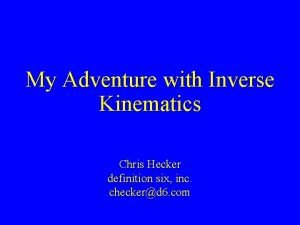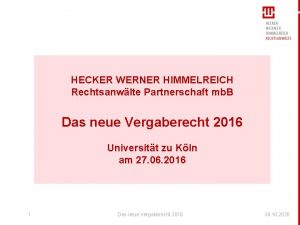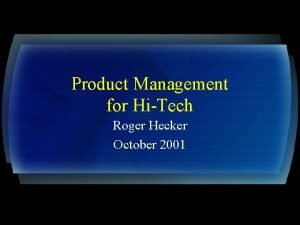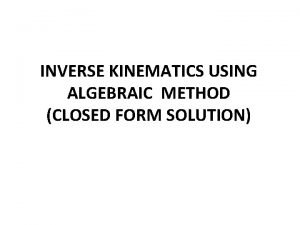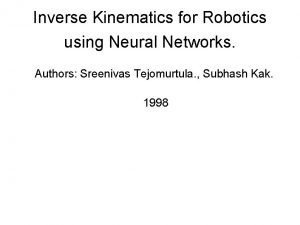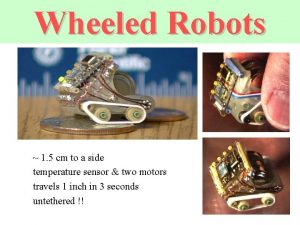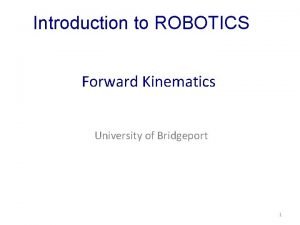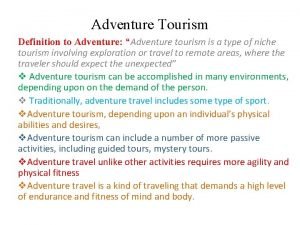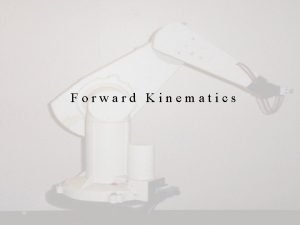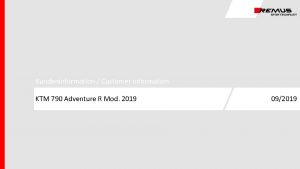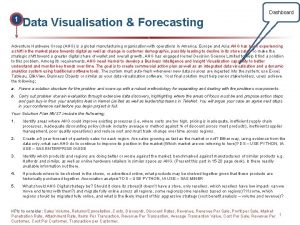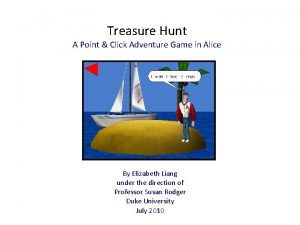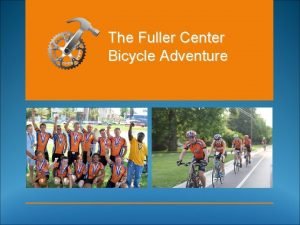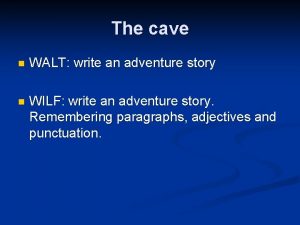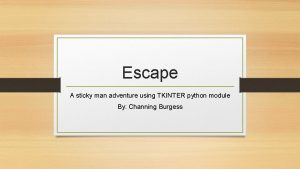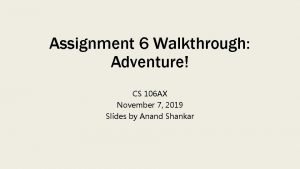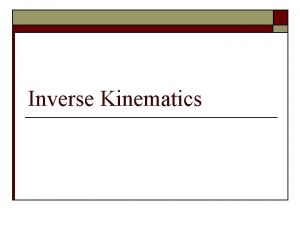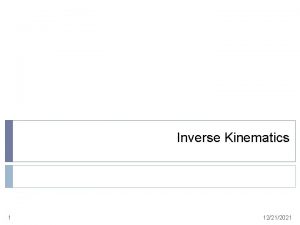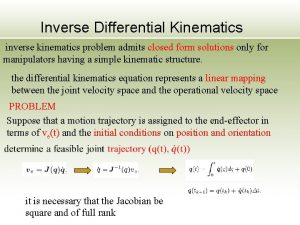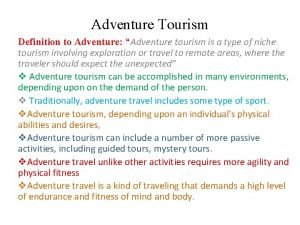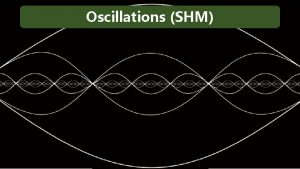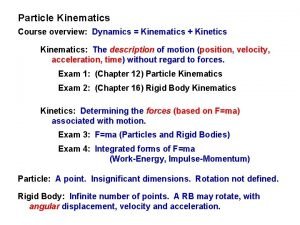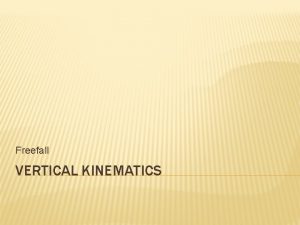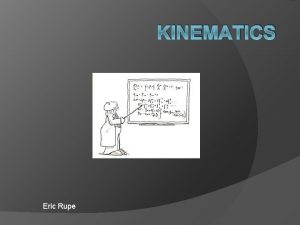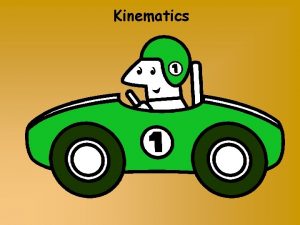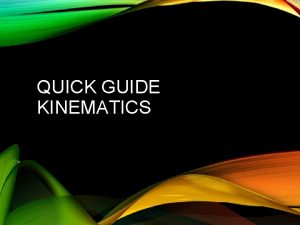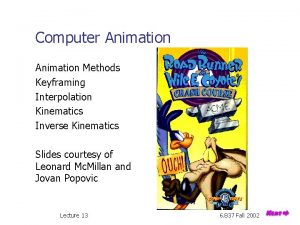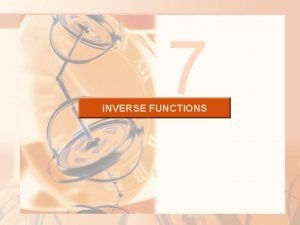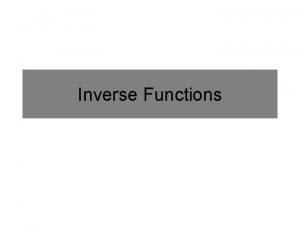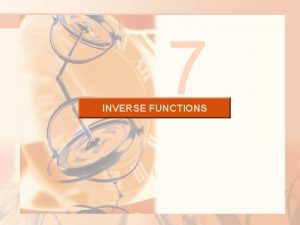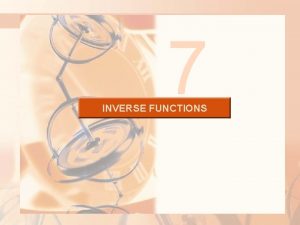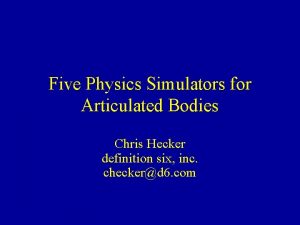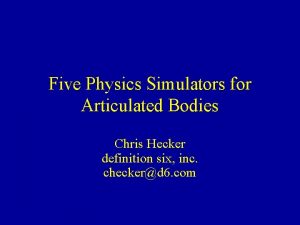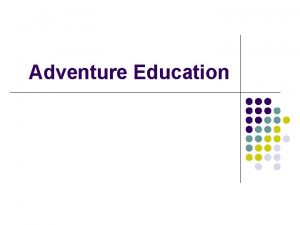My Adventure with Inverse Kinematics Chris Hecker definition







































- Slides: 39

My Adventure with Inverse Kinematics Chris Hecker definition six, inc. checker@d 6. com

What is this lecture about? • the path I took while solving a problem with inverse kinematics • how I use math to model and [sometimes] solve problems • decisions I made, both good and bad • learn from my successes and failures • work in progress!

What isn’t this lecture about? • not an IK tutorial or introduction • not going to give you the One True Way to do IK • has nothing to do with graphics • not about my rock climbing game • Experimental Gameplay Workshop Friday, 4 pm - 7 pm

Takeaway • You will get insight into how IK on a whole human body is different from IK on a single arm. • You will see how IK is a building block, but not a complete solution to character animation.

Prerequisites • must be very comfortable with math – doesn’t mean you know tons of math – does mean you follow quickly and aren’t afraid of it • probably best if you’ve implemented a simple IK system – foot placement, arm grabbing door, etc.

Talk Structure (linear with occasional branches) • • . . . attempted solution problem statement and discussion related theory. . .

Problem: How to move a guy with the mouse? • • move like a [rock climbing] human interactive direct body/limb control did not want to use physics

Theory: How to move a guy with the mouse? • inverse kinematics vs. forward kinematics – FK: p=f(q) – IK: q = f-1(p) – p is Euclidean, angles – q is configuration space p = (x, y) q = (q 1, q 2) g p q 2 q 1

Theory: How to move a guy with the mouse? (cont. ) • degrees of freedom (DOF) p q 2 • incredibly important concept • “ways in which system can change” • configuration space • find DOF of system to understand it • control & constrain DOF to control it • examples q 1 p = (x, y) q = (q 1, q 2) • physical system, polynomial, etc. • fundamental task of IK is to control degrees of freedom to attain goal

Solution: How to move a guy with the mouse? • analytical IK • invert p = f(q) to get q from p • relatively easy for the 2 D arm – inverse trig, some vector algebra • gets complicated as n increases

Problem: Analytical IK can’t handle human. • human has lots of DOF q 3 – even 2 D arm with shoulder has more DOF than needed to reach goal • solving p = f(q) requires certain characteristics q 2 q 1 p = (x, y) q = (q 1 , q 2 , q 3) p g

Theory: Analytical IK can’t handle human. • p = f(q) is a set of nonlinear equations – generally no closed forms – must iterate numerically q 3 q 2 • must be square, n. DOF = ngoal • over-, under-constrained system – “redundant manipulator” – ex. human reaching for point and/or orientation • vast literature on solving f(q) = p p q 1 p = (x, y) q = (q 1 , q 2 , q 3)

Solution: Analytical IK can’t handle human. • use Cyclic Coordinate Descent (CCD) to solve arms – iterative, recursive position-space algorithm – fast, easy, robust – start from last position • not path independent, but faster – I draw every outside iteration • looks like animation, but it’s not q 3 p g q 2 q 1 p = (x, y) q = (q 1 , q 2 , q 3)

Problem: CCD only handles serial chains. p • multiple goals are necessary for human – stack up vectors in p=f(q) – coupled at branches 2 g 2 q 3 q 5 p 1 g 1 q 4 q 2 q 1 p = (x 1, y 1, x 2, y 2) q = (q 1 , q 2 , q 3 , q 4 , q 5)

Theory: CCD only handles serial chains. p • coupling between goals g 2 • either solvable alone, neither solvable together • how to distribute desired-angle error? 2 q 3 q 5 p 1 g 1 q 4 q 2 q 1 p = (x 1, y 1, x 2, y 2) q = (q 1 , q 2 , q 3 , q 4 , q 5)

Solution: CCD only handles serial chains. p • simply average desired angles at branch parents to attain q 5 multiple goals and distribute error – q 1 in example, imagine p 1, p 2 pulled in opposite directions 2 q 3 p 1 q 4 q 2 q 1 p = (x 1, y 1, x 2, y 2) q = (q 1 , q 2 , q 3 , q 4 , q 5)

Problem: Drift on multiple goals. • average can’t satisfy all goals • or even prioritize them • I specifically want to drag climber hand with mouse and have other end effectors stay on holds q

Theory: Drift on multiple goals. • want a rigid constraint at end effectors • closed loops are hard, CCD doesn’t handle them, nor do common IK algorithms – must solve simultaneously – not hierarchical anymore – closed loops don’t have local behavior q

Solution: Drift on multiple goals. • attempt to “Gram-Schmidt” off any movement that would result in error b c a

Problem: Gram-Schmidt removes the wrong direction sometimes. • could have tried real Jacobian force mapping Gram-Schmidt

Problem: Human is not rooted tree. • Which end effector (hand, foot) is the root? • There is no persistent fixed root in a rock climber – or walking person • CCD must start at a fixed root

Theory: Human is not rooted tree. • switching root is basically a datastructure problem • relative angles must change – joint limits (see below) • behavior will change slightly as well, since CCD isn’t symmetric with respect to the root

Solution: Human is not rooted tree. • just type it in • invert tree to new root • Caml is pretty good at this sort of thing – see last year’s GDC talk • dragging torso is done by inverting to a torso node, then changing the root position – the hands and feet are all end-effectors – hack!

Problem: Joint limits • elbow can’t bend backwards • should lend believability and intuition

Theory: Joint limits • inequality constraints: q ³ qmin – abandon all (most) hope of analytical solution – these inequalities are axis aligned planes in configuration space qmax q qmin

Solution: Joint limits • • CCD makes parent-child limits easy do min/max clamp in CCD inner iteration easy, and rest of system compensates issue: CCD doesn’t “know” about the joint limits – often compensates, but doesn’t know to avoid them

Problem: Child-child limits • parent-child not enough with moving root • pelvis example: – left foot root – right foot root – chest root

Problem: Child-child limits • parent-child not enough with moving root • pelvis example: – left foot root – right foot root – chest root

Problem: Child-child limits • parent-child not enough with moving root • pelvis example: – left foot root – right foot root – chest root ?

Theory: Child-child limits • both angles are dependent on each other, coupled – parent is fixed in CCD – constraints are now non-axis aligned planes in C-space • simultaneous solution necessary at branches with child-child limits

Solution: Child-child limits • Good solution should: – satisfy constraints always – have zero error in goals if possible – have least squares error if not possible • Nonlinear Least Squares with Linear Inequalities: minimize (q 1 - d 1)2 + (q 2 - d 2)2 w. r. t. qmin 12 £ q 1 - q 2 £ qmax 12 – lots of literature on NLSLI – I convert to LCP and use Lemke’s algorithm – works great!

Accomplishments • We extended CCD to handle: – multiple end effector goals – dynamically changing root node – arbitrary joint limits

Problems • drift on multi-goals is still a problem • CCD doesn’t know about joint limits • sometimes non-physical movement – CCD isn’t doing physics, not conserving energy, or anything else for that matter • rooted hierarchies are inconvenient • how to control redundant DOF?

Body Knowledge System • system to manage movement and keep it natural – “situation” & “reaction” – ex. joint limits handled in body knowledge • huge rules system • allocates redundant DOF – this is the key to natural movement!

Body Knowledge System (cont. ) • IK just a rough initial guess for body knowledge system; should be: – physically plausible • no added energy, etc. – easy to layer conflicting goals – able to cope with over-constrained goals • don’t know enough about this yet, but I think it will be more important than IK for good dynamic animation

What I Didn’t Talk About • development process stuff – developing on lower dimensional subproblems – using visualizations to help debug math – Mathematica and Matlab for development and debugging – running multiple techniques on top of each other • physics-based techniques I tried

What I Didn’t Try • I should have done a weighted average based on error for multi-goals, duh. – even weighted average wouldn’t be rigid • although could make weight very big. . . • similar to a stiff system • Wrong: “CCD must have fixed root” – now that I understand better, this isn’t actualy true • the root’s position is just more DOF • CCD probably wouldn’t deal with this very well?

What I Didn’t Try (cont. ) • pseudo-inverse methods • give explicit control over redundant DOF • data-based methods (model-based) • functions as lookup tables • totally ad-hoc methods

References • two great theses: – Paolo Baerlocher – Chris Welman • google & citeseer • GDC talks – David Wu – Ken Perlin • Jeff Lander’s articles & code • Experimental Gameplay Workshop
 Chris hecker
Chris hecker Aplusphysics kinematics-horizontal kinematics
Aplusphysics kinematics-horizontal kinematics Hecker werner himmelreich
Hecker werner himmelreich Hecker pgp
Hecker pgp Hannah seymour
Hannah seymour Roger hecker
Roger hecker Friedrich hecker schule sinsheim
Friedrich hecker schule sinsheim Inverse kinematics algebraic method
Inverse kinematics algebraic method Inverse kinematics
Inverse kinematics Tricycle kinematics
Tricycle kinematics Spherical wrist robot
Spherical wrist robot Adventure learning definition
Adventure learning definition Adventure travel definition
Adventure travel definition What is fluid kinematics
What is fluid kinematics Kinematics definition
Kinematics definition Phasels wood
Phasels wood The adventure begins reading comprehension answers
The adventure begins reading comprehension answers Adventure story features
Adventure story features Finding nemo hero's journey
Finding nemo hero's journey Perseus crossing the threshold
Perseus crossing the threshold Manor adventure lockerbie
Manor adventure lockerbie Remus ktm 790 adventure
Remus ktm 790 adventure Mulan heros journey
Mulan heros journey Hercules road of trials
Hercules road of trials Adventure hardware
Adventure hardware Youtube
Youtube Sunny's adventure 2009
Sunny's adventure 2009 Bungee climbing
Bungee climbing How to make a point and click adventure game
How to make a point and click adventure game Fuller center bike adventure
Fuller center bike adventure Paragraph about an adventure story
Paragraph about an adventure story The 8 sectors of tourism
The 8 sectors of tourism Deserted island game
Deserted island game Sonic rush review
Sonic rush review Minion adventure
Minion adventure Sticky in tkinter
Sticky in tkinter Adventure high walkthrough
Adventure high walkthrough Adventure tourism essay
Adventure tourism essay Closed thesis
Closed thesis Honest word formation
Honest word formation
